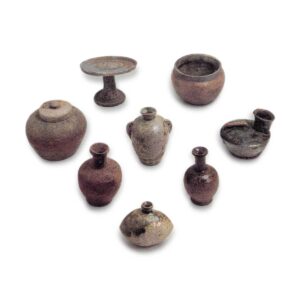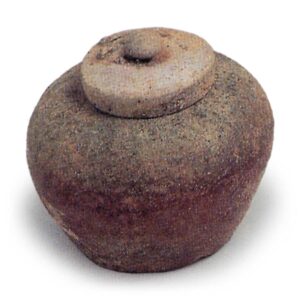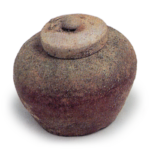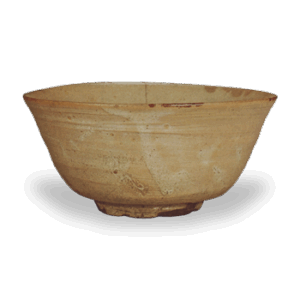

Excavated from Sanage Kiln, Aichi Pref.
8th – 9th century
(Double-eared vase) Height 6.4cm, mouth diameter 2.0cm, body diameter 4.6cm, bottom diameter 2.5cm
Aichi Prefectural Ceramic Museum
The vessels shown here are all small imitation vessels of 5 to 6 cm in height. The tall cup and bowl in the back were excavated from Kiln No. 32 in Narumi and date to the late 8th century, when ash-glazed ceramics were first produced at the Sanage kiln. These two items are unglazed. The small jar with lid and long-necked bottle on the left were excavated from Kurozasa Kiln No. 40 in the late 8th century and are unglazed.
The other four are from Kurozasa Kiln No. 7, all ash-glazed, and date to the latter half of the 8th century. The Sanage kiln produced many small wares like this one, especially from the late 8th to the early 9th century. All of them are wheel-thrown water-whittled pieces and show exactly the same style as the large utilitarian pieces.
In particular, many of the pieces from Kurozasa Kiln No. 7 are elaborate white wares with a light green ash glaze, a characteristic that makes them easily distinguishable from wares from other kilns. A small twin-ear vase made by the same kiln was excavated from a ritual site in Ohbishima, Kasaoka City, Okayama Prefecture, and a small horizontal vase was excavated from the Ichijoin site of Kofukuji Temple in Nara City. Both sites have excavated a large number of three-color, green glazed pottery vessels, and the fact that these vessels were found together with these vessels suggests that these vessels were used as ritual utensils. It is particularly interesting to note that the concentration of these wares tends to be from the latter half of the Nara period to the beginning of the Heian period, which is related to the nature of colored glazed ceramics.








